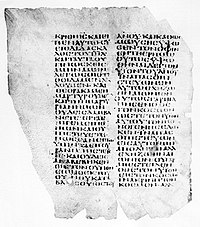| New Testament manuscript | |
 Page of the codex with text of John 3:10-17 Page of the codex with text of John 3:10-17 | |
| Name | Borgianus |
|---|---|
| Sign | T |
| Text | Luke and John |
| Date | 5th century |
| Script | Greek-Sahidic diglot |
| Now at | Vatican Library |
| Size | 26 cm by 21 cm |
| Type | Alexandrian text-type |
| Category | II |
| Note | close to codex B |
Codex Borgianus, designated by T or 029 (in the Gregory-Aland numbering), ε 5 (von Soden), is a Greek and Sahidic uncial manuscript of the Gospels, dated palaeographically to the 5th century. The name of the codex came from its former owners.
Contains
The Greek text of the codex contains:
- Luke 6:18-26; 18:2-9.10-16; 18:32-19:8; 21:33-22:3; 22:20-23:20; 24:25-27; 29-31;
- John 1:24-32; 3:10-17; 4:52-5:7; 6:28-67; 7:6-8:31.
The Sahidic text of the codex contains:
- Luke 6:11-18; 17:29-18:9; 18:?-42; 21:25-32; 22:12-23:11; 24:18-19; 24:21-23;
- John 1:16-23; 3:2-10; 4:45-52; 6:21-58; 6:58-8:23.
Description
The codex contains 17 parchment leaves (26 cm by 21 cm), with fragments of the Gospel of Luke 6, 17-19, 21-24 and Gospel of John 1, 3-4, 6-8. The manuscript is written in two columns per page, 26-33 lines per page, with the Greek and Sahidic on facing pages. Lines are very short, only 6, 7, 8, and 9 letters in lines. It is written in large letters compressed only on the edge. The letters are square. Tischendorf suggested the scribe was a Copt, because the letters often show Coptic forms. There is no notation of sections or other divisions. The shapes of alpha and iota are specially noticeable. It has no accents and breathings.
Text
The Greek text of this codex is a secondary representative of the Alexandrian text-type (named also Egyptian text) with a mixture of the Byzantine readings. Kurt Aland placed it in Category II. The Alexandrian text of the Gospel of John stands in close relationship to the Codex Vaticanus, and P.
The text of Luke 22:43-44 is omitted, as in codices p, א*, A, B, 1071.
It does not contain John 5:4 (0125) or the Pericope Adulterae (John 7:53-8:11).
It reads βηθαβαρα in John 1:28 and βηθσαιδα in John 5:2.
History
The manuscript came from the White Monastery. It once belonged to Cardinal Stefano Borgia, hence the name of the codex.
Fragments of the codex were discovered independently at separate times and were numbered 029, 0113, 0125, and 0139. Together they have 23 leaves. "It appears that the ignorant monk who brought this manuscript with him from Egypt to Europe, was so unaware of its value, that he lost the greater part of the leaves".
The text of Codex 029 was carefully edited in 1789 by A. A. Giorgi. The manuscript was examined by Birch, who collated the Greek text of 029. Birch gave this description of the codex:
Codex in membranis scriptus est, charactere unciali quadro, graeco textui adjecta est versio coptica. Vehementer sane dolendum, particulam tam exiguam eximini codicis servatam esse, ex quo, si integrum aetas tulisset, plurima ad textus emendationem peti potuissent.
Henri Hyvernat purchased two pages in 1912 in Cairo for John Pierpont Morgan.
Present location
A few leaves from Uncial 070, formerly designated by T, were wrongly listed by Tregelles as a part of the same codex to which Borgianus belonged.
The codex is located at the Vatican Library (Borgia Coptic 109), in New York City (Pierpont Morgan M 664A), and in Paris (BnF Copt. 129).
See also
References
- ^ Aland, Kurt; Aland, Barbara (1995). The Text of the New Testament: An Introduction to the Critical Editions and to the Theory and Practice of Modern Textual Criticism. Erroll F. Rhodes (trans.). Grand Rapids: William B. Eerdmans Publishing Company. p. 113. ISBN 978-0-8028-4098-1.
- Gregory, Caspar René (1900). Textkritik des Neuen Testaments. Vol. 1. Leipzig: J. C. Hinrichs’sche Buchhandlung. pp. 72–73.
- Scrivener, Frederick Henry Ambrose; Edward Miller (1894). A Plain Introduction to the Criticism of the New Testament. Vol. 1 (4 ed.). London: George Bell & Sons. p. 147.
- Kurt Aland and Barbara Aland, The Text of the New Testament..., pp. 113, 160.
- Bruce M. Metzger, Bart D. Ehrman, The Text of the New Testament: Its Transmission, Corruption and Restoration, Oxford University Press, 2005, p. 80.
- UBS3, p. 305
- UBS3, pp. 337, 356.
- S. P. Tregelles, "An Introduction to the Critical study and Knowledge of the Holy Scriptures", London 1856, p. 180
- A. A. Giorgi, Fragmentum evangelii S. Johannis Graecum Copto-Sahidicum, Rome 1789.
- A. Birch, Variae Lectiones ad Textum IV Evangeliorum, Haunie 1801, p. LVII
- "Liste Handschriften". Münster: Institute for New Testament Textual Research. Retrieved 16 March 2013.
Further reading
- E. Amélineau, "Notice des manuscrits coptes de la Bibliothèque nationale renfermant des textes bilingues du Nouveau Testament. Notices et extraits des manuscrits de la Bibliothèque nationale et autres bibliothèques", tome XXXIV, 2e partie NEMBM 34/2 (Paris: 1985), pp. 372, 406-407. (Uncial 0125)
- P. J. Balestri, Sacrorum bibliorum fragmenta copto-sahidica Musei Borgiani, Novum Testamentum III (Rome, 1904), pp. 202–218, 234–260.
- Adolphe Hebbelynck (1912). "Les Manuscripts coptes-sahidiques du Monastère Blanc". Le Muséon. 13: 351–352.
- Paul Canart, Note sur le manuscrit T ou 029 du Nouveau Testament, Biblica, Vol. 84 (2003), pp. 274–275.
- P. Franchi de'Cavalieri, Codices graeci Chisiani et Borgiani (Rome, 1927), pp. 161–162.
- C. R. Gregory (1900). Textkritik des Neuen Testaments. Vol. 1. Leipzig. pp. 69–70 (Uncial 0139), 72-72 (Uncial 029).
{{cite book}}: CS1 maint: location missing publisher (link)
External links
- "Liste Handschriften". Münster: Institute for New Testament Textual Research. Retrieved 21 April 2011.
- Codex Borgianus T (029): at the Encyclopedia of Textual Criticism
- Uncial 029 at the Wieland Willker, "Textual Commentary"
- Uncial T/029 New York fragments full text of "New York Fragments" at the Wieland Willker, "Textual Commentary"